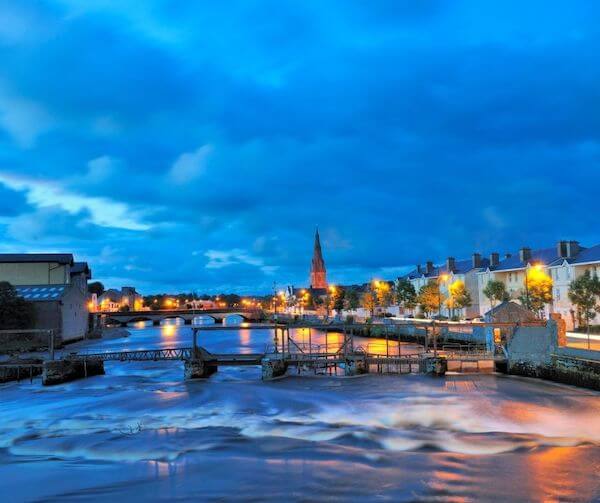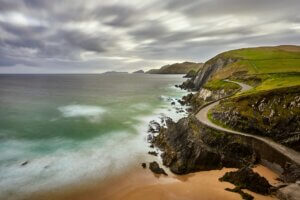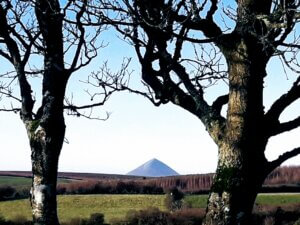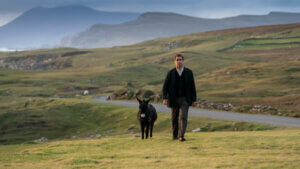Ballina in County Mayo is a place that President Joe Biden holds dear to his heart, having visited the small West of Ireland town in 2016 and most recently in April 2023.
This post contains affiliate links and I may earn compensation when you click on the links at no additional cost to you.

The 46th president's maternal great-great-grandfather Patrick Blewitt left Ballina in 1850 at a time when Ireland's population was suffering from the greatest mass starvation in its history, otherwise known as The Great Hunger.
By clicking on the Amazon link above, I may earn a small commission from the Amazon Associates Program. However, you will not incur any additional costs by doing so.
The West of Ireland, and in particular, Co. Mayo was hit very badly.
The Story of the Blewitts
Biden's ancestor, Patrick, was the son of Edward Bluett, who worked on the Ordinance Survey of Ireland and later on Griffith's Valuation, a type of census at the time.

His father, who studied engineering in Dublin, was also an overseer at the Ballina workhouse where many destitute families came during the Famine in need of food and shelter.
According to Patrick Blewitt's obituary published in The Scranton-Times Tribune on Nov. 27, 1911, he fled Ireland while a teenager after getting into a fight with his father.
Blewitt, who was one of nine children, was bound for America when the ship he was on caught fire.
Finding himself back in Liverpool again (the most important port of departure for emigrants from Europe because of its well-stablished transatlantic links), the young lad got on another ship and ended up in Chili.
He didn't reunite with his father, mother and siblings until some years later when his father, Edward, was in Pennsylvania working as a weigh-master in the Sand Banks region of the Lackawanna Valley, a coal-rich region that drove America's Industrial Revolution in the 1800s.
Edward Blewett would later assist Joel Amsden in laying out and surveying the city of Scranton, Pa.
You can learn about the amazing life of Patrick Blewitt in from this newspaper obituary shortly after his death.
During President Biden's visit to Ireland five years ago, he received a full accounting of his family's Irish background and how they made it to the United States.
This year's visit to the town, which celebrates its 300th anniversary, comes during his official visit to the island of Ireland as part of the 25th anniversary of the Good Friday Agreement.
Biden is the 23rd Commander in Chief to have roots on the island of Ireland.
Sign up for a Free Trial of Ancestry.com
The History of Ballina
Ballina, which is twinned with Scranton, Biden’s birthplace, was founded in 1723 by Charles O’Hara, the First Baron of Tyrawley, locally known as Lord Tyrawley.
From 1714 to 1721, he was commander-in-chief of the Royal Irish Army.
Ballina was originally known as Belleek.
During the Irish Rebellion of 1798, a small group of French soldiers walked through the estate on their way to Killala to fight against the British Crown forces.
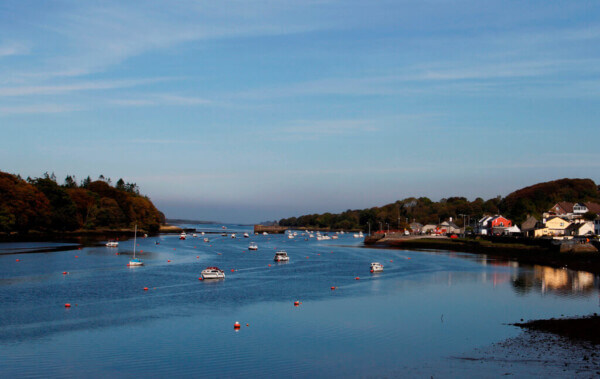
The town, with a population of about 10,000 people, is situated on the River Moy and as such was developed as a seaport and market town, expanding when The Quay was developed in 1836.
During the Great Famine of the 1840s, the above-mentioned workhouse, formally known as the Ballina Poor Law Union, was built in the town.

It was one of the largest workhouses in the country, designed to accommodate 1,200 people.
The only reminder of its existence today is a dispensary building.

In 2003, a memorial plaque was erected on the building, which acknowledges the presence of two mass graves nearby.
From this workhouse, 87 young girls were sent in three ships to Australia.
They are known as the Mayo Orphan Girls.
Throughout the 19th and 20th centuries, Ballina was a busy place, importing coal, cement, tar, timber, as well as food (mostly tea, fruit, and coffee).
During World War II, livestock was regularly exported to England from Ballina.
By clicking on the Amazon links below, I may earn a small commission from the Amazon Associates Program. However, you will not incur any additional costs by doing so.
Read Christine Kinnealy's book, “A Death-Dealing Famine: The Great Hunger in Ireland”
What to See When You Visit Ballina
If you’re in Ballina for any length of time, be sure to visit Belleek Castle and in particular, its fascinating armor collection.
The house (named after a 13th-century tower house called Belleek Castle that stood on the banks of the Moy), was built in 1825 and completed in 1831.

Commissioned by Sir Arthur Francis Knox-Gore, the total cost to build the Tudor Gothic revival mansion, considered the finest in Connacht at the time, was £10,000.
Nestled on the edge of Belleek Woods, the new house replaced a structure previously built by the Knox-Gores.
On the first floor alone, you’ll discover a large entrance hall, an equally large drawing room with a carved white mantelpiece bearing the Knox-Gore coat of arms, in addition to a dining room, library, study, and morning room.
Knox-Gore lived in the house until his death in 1873. A large Neo-Gothic monument located in the nearby Belleek Woods marks the spot of his internment.
His wife and favorite horse are also said to be buried there, as is Knox-Gore’s son, Charles, along with his beloved dog Phizzie.
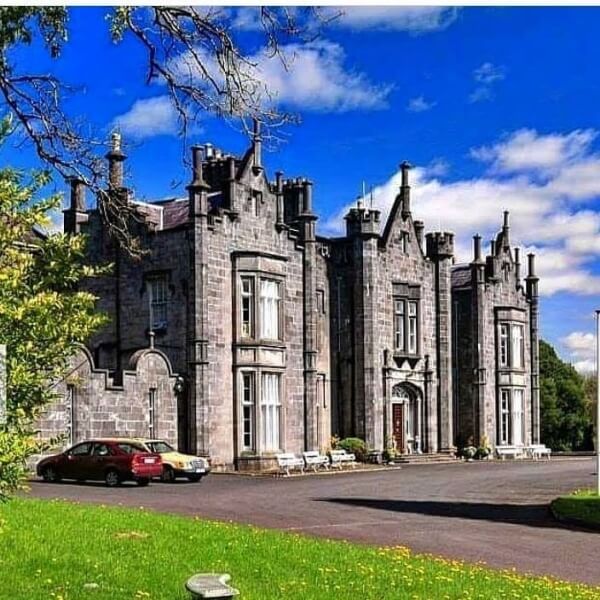
In 1942, it was sold to the Becketts, a local family. They subsequently sold it to Mayo County Council, which turned it into a hospital and military barracks.
It wasn’t until Navy Merchant Officer Marshall Doran purchased it that Belleek Castle was returned to its former glory.
Doran was an avid collector of medieval treasures. You can see many of them in the basement of the castle when you take a guided tour.
They include a large collection of medieval armor and weaponry, some rare fossils, even the bed of the Irish Pirate Queen Granuaile, otherwise known as Grace O’Malley! A virtual tour of the castle/hotel is available.
Belleek Woods
The Belleek Woods that you see today is in many ways due to the vision of Knox-Gore, a benevolent man who took care of his workers and tenants and also had a keen interest in planting and agricultural practices.
During the development of the estate, Knox-Gore planted thousands of natural broadleaf deciduous trees, including oak, ash, elm, and larch trees.

Many of them form the basis of the present-day Belleek Woods, which stretches for six miles along the banks of the River Moy, making it one of the largest urban forests in Europe.
You’ll find a number of trails in Belleek Woods that make it an ideal place for walking or cycling. There is also a lovely picnic area near the river.

https://www.flickr.com/photos/cianginty/ https://creativecommons.org/licenses/by-nc-sa/2.0/
As mentioned above, you’ll discover the mausoleum where Knox-Gore is buried, but look to the river and you’ll see the concrete tug boat known as the “SS Crete Boom,” which was built by the British during World War I but was never used.
The Ballina Harbour Commissioners purchased the wreck with the intention of using it to form a sand barrier at the entrance of the river. The plan didn’t work. The vessel sank and remained underwater until 1974.
You’ll also find an icehouse and an old “famine wall” built during the mid-1800s.
Booking.com
Connacht Whiskey Distillery
Close to Belleek Castle and woods is the Connacht Whiskey Distillery, which is one of close to 50 whiskey distilleries in operation throughout Ireland.
The 2,500-meter facility houses three copper pot stills that are used to make its signature brand, Connaught Irish Whiskey.
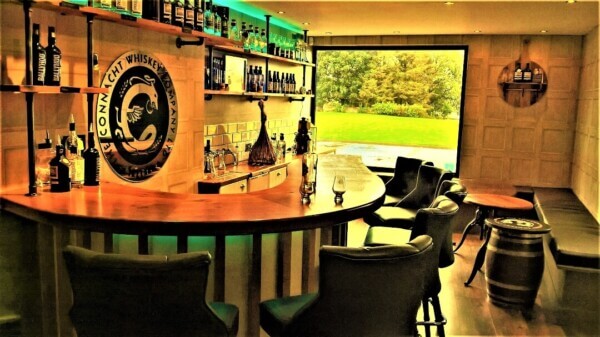
Its double distilled single malt whiskey is reflective of the local landscape as local grains are used in its making as well as water from two County Mayo lakes, Lough Conn and Lough Cullin.
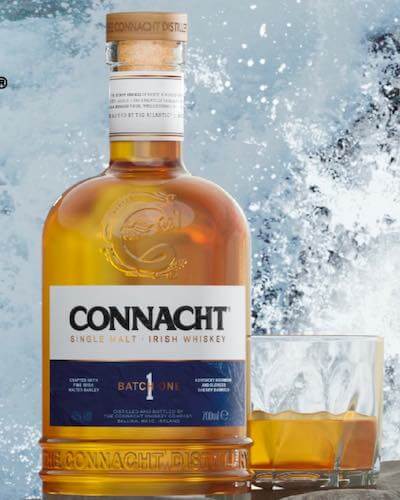
The Connacht Whiskey Distillery also produces the following brands:
- Brothership 10-Year-Old Whiskey, a unique blend of Irish single malt whiskey and light American whiskey, which represents the intertwined Irish and American cultures;
- Concullin Irish Gin, hand-crafted small batch Irish gin inspired by the water and Irish botanicals sourced from Lough Conn and Lough Cullin;
- Spade and Bushel 12-Year-Old Irish Whiskey, a limited-edition whiskey that is finished in premium select first-fill bourbon casks.
- Spade and Bushel 5-Year-Old Amarone – finished in Amarone wine casks, with partially-dried Corvina, Molinara and Rondinella grapes.
- Straw Boys, a single malt Irish whiskey that takes its name from the illegal Irish moonshine made in the Irish countryside for centuries.
- Straw Boys Vodka, a premium Irish vodka that has been distilled five times in copper pot stills, giving the products its luscious, silky and semi-sweet taste.
All the products can be purchased online at the Irishmalts website or at the distillery’s online shop.
Guided tours/tastings are offered by appointment only. Email [email protected].
Take a Wild Atlantic Cultural Tour with Denis Quinn
The Jackie Clarke Collection
What might seem like an unassuming place at first glance is actually a fascinating look into Irish history.
The Jackie Clarke Collection is housed in the former 3-story Provincial Bank building on Pearse Street in the center of town.
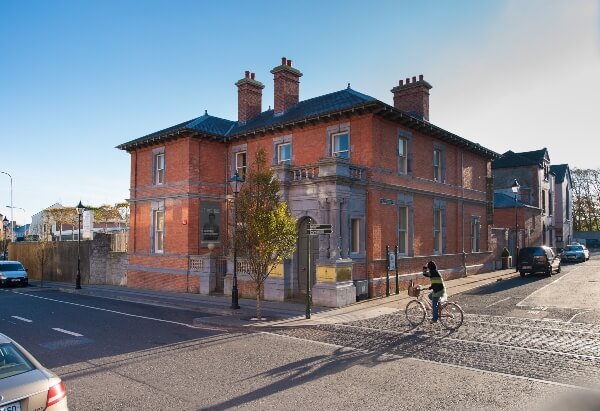
It was designed by the Victorian architect Thomas Manly Deane, who also designed the National Museum in Dublin and that city’s government buildings.
The rare and precious items that you’ll discover here are the result of years of collecting by the late Jackie Clarke, a local businessman.
The Jackie Clarke Collection Ballina Mayo InflightFlix from InflightFlix on Vimeo.
His love of historical items began when he was a schoolboy in the 1940s.
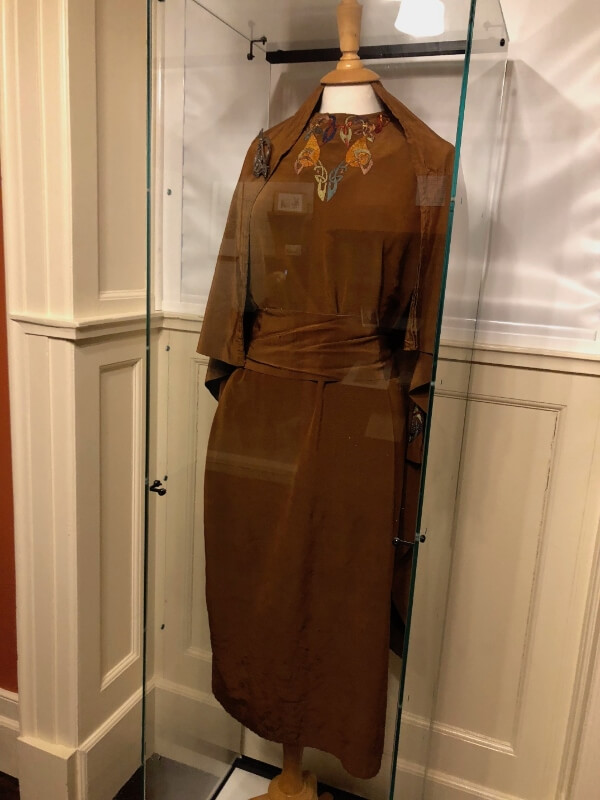
What started out as memories and collections in a scrapbook soon turned into a true passion as Clarke gathered the letters of Irish political figures, rare books, posters, and an impressive collection of maps, some as old as 400 years.
Some of the items that are housed here include letters from Michael Collins, Douglas Hyde, Michael Davitt, and O’Donovan Rossa, as well as plenty of personal items related to the leaders of the Easter Rising in 1916.
The attraction is open from Tuesday through Saturday, 10 a.m. to 5 p.m.
The Monasteries of the Moy: Rosserk Friary and Moyne Abbey
It is here that you will discover the ancient ruins of Rosserk Friary and Moyne Abbey, both National Monuments and once belonging to the Franciscan Order.
Both were destroyed in the 1500s after King Henry VIII ordered that all monasteries in Ireland close.
Rosserk Friary, which was built in 1460 by the Joyce family, is a peaceful place along the banks of the Moy and about a 13-minute drive from Ballina.
Look out for the finely carved west doorway, the single-aisle church, and its unique double piscina (a stone basin near the altar used for washing vessels during mass).
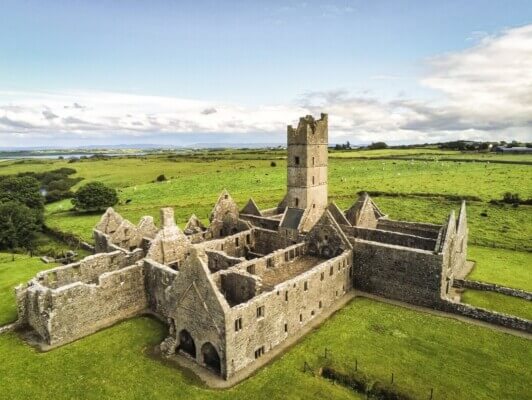
Moyne Abbey, about 6 miles (9 km) from the town, is also along the Moy estuary. It was founded by the McWilliam Bourke family and consecrated in 1462.
Its extensive ruins include a church and domestic buildings situated around a central cloister.
Both friaries were built in the late Irish Gothic style.
If you want to truly explore this area around Ballina in County Mayo, hop on your bike or take a walk on the Monasteries of the Moy Greenway, a 14-km (8-mile) off-road walking and cycling route between Killala and Ballina.
You can rent bikes from Killala Bike Hire.
Have you visited Ballina in County Mayo? If so, let me know the attractions you enjoyed in the comments section below.

